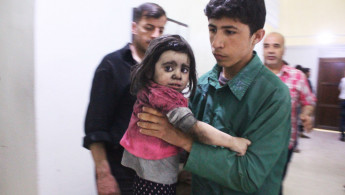Children killed as Syrian regime breaks ceasefire agreement after deadly airstrikes on opposition-held Damascus town
The civilians deaths in Eastern Ghouta were the first in the last major rebel stronghold near Damascus since a cessation of hostilities declared on Saturday.
More than 30 people were wounded in the strike on the town of Arbin, with at least five children reported killed.
"This is the first time that civilian martyrs have fallen as a result of regime or warplane bombardment since the start of the ceasefire agreement in the Eastern Ghouta," the Civil Defence for rural Damascus said.
There was no immediate mention on Syria state media of the airstrikes or comment from the Syrian regime’s military.
The army announced a halt in fighting in areas of Eastern Ghouta on Saturday from noon local time, but did not say which areas exactly would be included.
The Syrian regime has also repeatedly broken previous ceasefire agreements.
The ceasefire announcement came after regime ally Russia said it had reached a deal with "moderate" rebels on the boundaries and policing of the safe zone.
It said the sides had also agreed "routes to supply humanitarian aid to the population and for free movement of residents".
But no rebel group yielding influence in Eastern Ghouta said they had signed that agreement.
The rebel enclave is in one of four proposed "de-escalation zones" designated in a deal reached by government allies Iran and Russia and rebel backer Turkey in May.
But the accord has yet to be fully implemented over disagreements on policing the safe zones.





 Follow the Middle East's top stories in English at The New Arab on Google News
Follow the Middle East's top stories in English at The New Arab on Google News
![The UAE is widely suspected of arming the RSF militia [Getty]](/sites/default/files/styles/image_330x185/public/2024-11/GettyImages-472529908.jpg?h=69f2b9d0&itok=Yauw3YTG)
![Netanyahu furiously denounced the ICC [Getty]](/sites/default/files/styles/image_330x185/public/2024-11/GettyImages-2169352575.jpg?h=199d8c1f&itok=-vRiruf5)
![Both Hamas and the Palestinian Authority welcomed the ICC arrest warrants [Getty]](/sites/default/files/styles/image_330x185/public/2024-11/GettyImages-2178351173.jpg?h=199d8c1f&itok=TV858iVg)